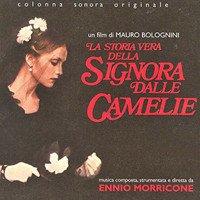- Composed by Ennio Morricone
- Cinevox / 59m
La Storia Vera della Signora dalle Camelie is a film by Mauro Bolognini telling the story of Alphonsine Plessis, the famous Parisian courtesan who inspired the novel The Lady of the Camellias by Alexandre Dumas fils (and the film was released under that title internationally). Starring Isabelle Huppert, the film is typical of Bolognini’s output, which often saw him making literary period films.
While many of those films have since faded into relative obscurity, they did inspire one of Ennio Morricone’s most prolific and productive directorial collaborations – he scored 15 films for the director over the years and wrote some of his most beautiful music in the process.

This score is one of the composer’s most classical-sounding, highlighting some exquisite piano solos. There is the trademark Morricone melancholy running through it and this is evident from the opening theme, which is exquisitely beautiful but also quite profoundly sad – particularly in the interplay between piano and flute as the piece develops.
The second cue, “Arrivo a Parigi”, is a Morricone classic – here there is an elegance that is irresistible, the flute taking centre-stage this time, the melody just drop-dead gorgeous. “Valzer” is, as its name suggests, a waltz – a gently rolling one for solo piano, no limit placed on the melancholy this time. A sung waltz is next, “Petite Créature”, vocals by Luciana Terina – it sounds period-appropriate (early 19th century) and has a paradoxical attractiveness despite the deliberate austerity that pervades Terina’s performance.
There is a change of pace in “Morte di un prete”, a wild and brassy piece of desperate action music. It’s slightly jarring to hear after what has gone before but adds a welcome additional flavour to the score. We are back to a romantic sound in “Amanti”, but once again the romance is far from straightforward – while outwardly attractive, there is a certain hesitance in the oboe solo which gives the piece a real depth.
“Passacaglia” returns to the main theme, the piano solo dancing around with great grace but the emotion again conflicted between beauty and sadness. Then we get a string-led variant on the secondary theme in “Unico amore”, one of the score’s most straightforwardly romantic pieces. “Fiore rosso” has a slightly different timbre, with some harp writing cleverly adding that touch of austerity again, and then “Valzer stonato” is very different – another waltz, this time performed by a calliope and sounding like the world’s saddest fairground ride.
The sadness really comes to a head in “Morte di Alfonsina”, an emotional powerhouse of a cue that resolves much of the inherent tension in the music to that point (and not in a neat, happy ending way). After this, “Fumeria d’oppio” is a piece of exotic snake charmer-style source music, and it rather shatters the mood that Morricone has so carefully crafted so I usually skip it because the actual finale is the heartbreaking “Amori senza amore” whose title speaks for itself and rather sums up the whole score. It’s a piece for solo piano and so desperately sad, a great demonstration of the composer at the peak of his dramatic powers.
This is an exquisitely beautiful score, as many of Morricone’s for the films of Bolognini were. It is achingly sad as well, quite powerfully at times (especially the end). It has been released numerous times on album under both its Italian and French titles (La Dame aux Camélias) and is currently widely available as a download, including ten additional cues which were also on the most recent Cinevox CD and are all variants on what was already there. Definitely one to get.
Rating: **** 1/2
facebook.com/moviewave | twitter.com/MovieWaveDotNet | amazon.com












It‘s quiet in here! Why not leave a response?